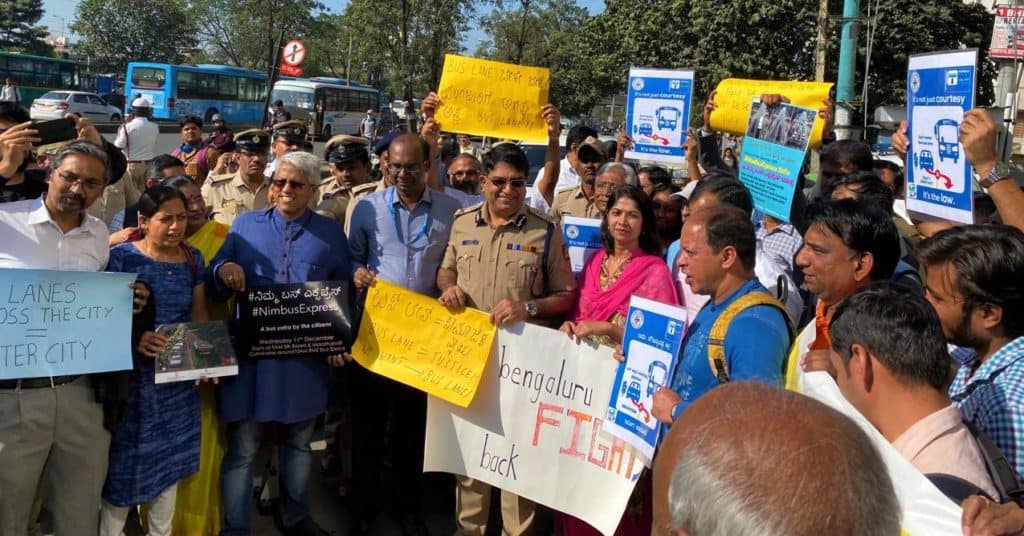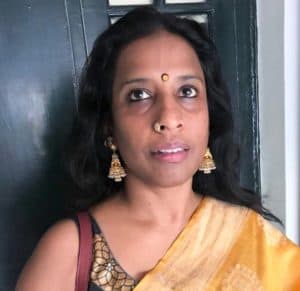Popular imagination would have it that campaigns begin and go on until their objective is achieved or rejected; and then they wind up. Not quite, says Tara Krishnaswamy, a veteran of several civic campaings in Bengaluru. Campaigns are seldom linear and their chronology is almost always chequered.
Tara was among many citizen activists who had pushed for the bus priority lane (BPL) along the Outer Ring Road (ORR). That was back in 2017. The world over, giving priority to public bus movement — through dedicated bus lanes or more complex systems like BRTS (Bus Rapid Transit Systems) — is acknowledged as a key factor in improving public transport and reducing traffic congestion. In ORR too, both commuters and the Bangalore Metropolitan Transport Corporation say that the BPL — implemented in 2019 — has reduced travel time significantly.
Read more: Bus lane has reduced stress, travel-time for drivers, increased ridership for BMTC
Presently, however, with Namma Metro starting construction work along the ORR, there is fear that the bus lane could be endangered. And citizen groups are now gearing up to save it.
The bus lane was a hard fought victory. How a small group of citizens convinced the government to implement the bus lane in the first place is worth recalling.
How the campaign started
The origins of the BPL campaign lie in another landmark campaign: Bengaluru’s protests against the steel flyover project in 2016-17. (The State government had to drop the Rs 1,791-cr project of building a 6.9-km steel flyover, following people’s protest).
As part of this mother protest, CfB had raised a set of demands to strengthen bus transport. This, CfB did in collaboration with bus advocacy forum BBPV (Bengaluru Bus Prayanikara Vedike).
Tara says, “Campaigning with BBPV, we raised multiple demands like doubling the bus fleet and halving the fare, introducing mini-buses and bus lanes, etc. The initial campaign was not exclusively for bus lane, but it was one of the demands. And we raised these demands with the BMTC repeatedly.”
With the protest against the elevated corridors project in 2019, the demands to strengthen bus transport became stronger, says Shaheen Sasha of BBPV. The massive elevated corridors project was seen as benefiting private vehicles only. “BBPV and CfB drove the campaign against elevated corridors based on the concept that everyone deserves equal space on the roads. There was more discussion about bus lane as an alternative,” she says.
Dr Ashish Verma, Associate Professor of Transportation Systems Engineering, IISc (Indian Institute of Science), says, “The campaigns against steel flyover and elevated corridors really led to a greater understanding among people about why such heavy infrastructure projects are bad for the city and what could be the alternatives. Because when you say that something is not going to work, you also need to say what would work.”
For years before these campaigns, Dr Ashish had made a case for bus lanes before several BMTC Managing Directors. His own research showed that BMTC’s ridership and profits would improve with bus lanes in specific roads. “The BMTC MDs were quite receptive to the idea, but at the level of decision-makers like ministers and MLAs, the understanding was minimal. So they shied away from it,” says Dr Ashish.
With the steel flyover protests, citizen groups like CfB and Save Bangalore Committee started organising events and panel discussions. This made it easier for him to communicate technical aspects of BPL to the public, says Dr Ashish.
The turning point
Tara says CfB started an exclusive campaign for bus lane in 2019, after the central government approved funding for the suburban rail project. The initial routes of the suburban rail project did not include the ORR stretch. Metro rail along this stretch had also not been approved at the time.
“So we made the case that six lakh people work in the Sarjapur-Bellandur area; it is a high-mobility area and also one of the highest revenue-generating areas; yet it’s least served by public transport. We demanded that at least BPL should be created in this route, so that bus commuters don’t have to sit three hours in traffic,” recalls Tara.
Also, around the same time, the commissioners heading BMTC and DULT (Directorate of Urban Land Transport) changed. “Every time these players change, it gives us a window of opportunity to refresh the demand. Sometimes a particular commissioner looks at certain things more favourably, or they also want to make a change. So the campaigns we run depends on what’s happening in the ecosystem too,” says Tara.
Read more: Podcast: What makes citizen activism in Bengaluru unique
CfB discussed their demand with C Shikha, the newly-appointed BMTC MD at the time. “We, along with BBPV gave her a formal representation on why the ORR stretch would be a perfect experiment for BPL: it’s a very wide corridor with multiple lanes, it already has many flyovers, etc. Unlike BRTS, you can pilot BPL with a far lower investment. Shikha was very open to the idea, and because she was convinced she back-channeled with other departments.”
The activists also wrote to the Chief Minister, and spoke to other departments like the BBMP, DULT and police who had to be involved in the implementation.
DULT designed the bus lane, BBMP created the physical infrastructure (marking the lane, placing bollards, etc), BMTC rationalised bus trips along the stretch, and the traffic police stepped in to enforce lane discipline. BMTC also held meetings with citizen groups and took their suggestions before the project was implemented. In November 2019, the bus lane was piloted in the 22-km ORR stretch between Silk Board and KR Puram.
A hawk eye over BPL
Even after the BPL was introduced, citizen activists continued their work. In December 2019, CfB and BBPV, along with two other citizen groups Whitefield Rising and Bellandur Jothege, organised a ‘NimbusExpress Yatra’ along the bus lane, to popularise it. Officials, citizen groups and celebrities took part in the trip.

In the first few months of the bus lane, citizen groups also documented the project, and pointed out niggles in its implementation. “Initially, many people had misgivings about the project – whether the space for other vehicles would reduce, if lane discipline can be maintained, etc. To address this, we put up a series of posts on social media giving details of the project and how it would reduce traffic jams overall,” says Pravir Bagrodia of Whitefield Rising.
“We also gave feedback to officials about issues that came up during implementation such as black bollards not being visible at night. These were then replaced with red bollards. We continued such work for the first six months of BPL implementation,” Pravir points out.
Shikha, who has now moved out of BMTC, says the bus lane was “totally a people-driven project”. “There was no resistance because everyone knew of the good it will do to the city. BPL was also a unique model where multiple departments came together to implement the project quickly,” Shikha recalls. She says that low cost and minimal infrastructure required for the project were among the reasons it got approved soon.
What next?
With the Metro construction work on ORR and likely to continue for several years, citizen activists are concerned about the future of the bus lane.
Tara says that sustaining the bus lane alongside Metro construction would require continued coordination between departments, support from local organisations, etc. She continues to coordinate with government agencies to ensure the bus lane project sustains.

In a recent meeting, DULT assured citizen groups that they are negotiating with Bangalore Metro Rail Corporation Ltd, the terms of the Metro line construction. Shaheen of BBPV says, “DULT told us that BMRCL has agreed, in principle, to reduce the road width blocked for construction by a small extent – 8.7 metre instead of 9 metre. Also, the track will be built first, and the stations will be built later, so that less road space has to be reserved for construction. DULT has also been asking BMRCL to limit the work to 2 km at a time.”
On their part, citizen groups have asked for better last-mile connectivity to the ORR so that more commuters can use the bus lane. Only the bus lane and one other lane for private vehicles would be available for commuters’ use during the construction of the Metro.
Another concern is whether bus lanes will indeed be created in other roads as well.
After the BPL were created along the ORR, The State government had proposed such lanes along 12 more corridors. But work on these has not started yet. Dr Ashish says, “Unless you implement BPL on a network level, you won’t see the desired effects like increased bus ridership and reduced traffic. This is what happened with BRTS in Delhi.” Shaheen says that DULT has said that BPL would soon to be extended to the rest of ORR, and work is about to start in Hosur Road as well.
For the activists, it is about continued coordination and sustaining the fight, to see that Bengaluru gets its network of bus priority lanes.
This article is part of a series on Civic Change in Bengaluru.
On grounds of project cost, flexibility and affordability for the commuter, public bus transport is a very desirable mode and should be fully supported. The government should quickly extend the BPL on many routes and augment the BMTC fleet. To control both congestion and pollution, private vehicles(mainly cars)have to be reduced and hence a big expansion of public bus transport is a MUST.